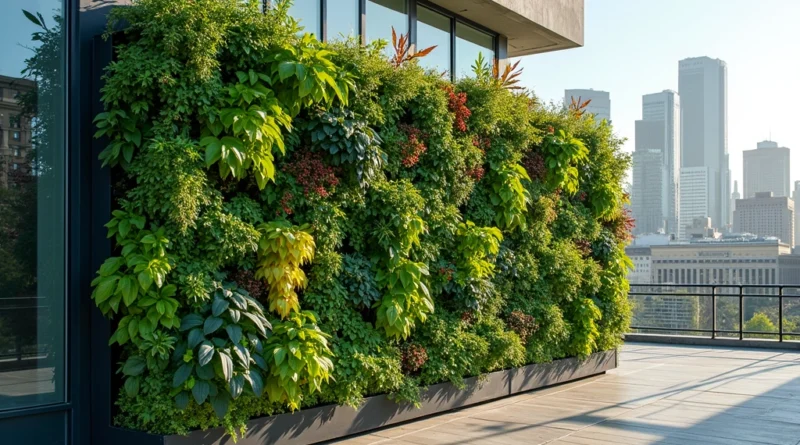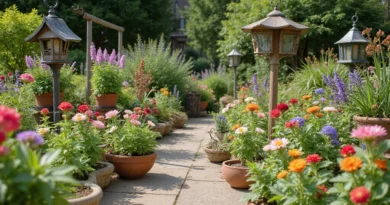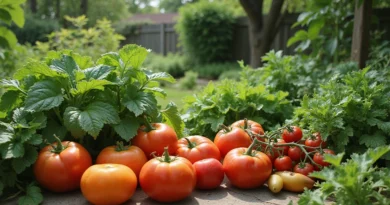How to Create a Beautiful Vertical Garden: Tips for Urban Gardening Enthusiasts
Vertical gardening is a fantastic way to bring greenery into your urban space, no matter how limited your square footage might be. These living walls can transform bland walls into lush oases, making your environment feel fresh and inviting.
Imagine cascading plants, vibrant flowers, and fragrant herbs thriving in a vertical arrangement that saves space and adds beauty. It’s not just about aesthetics; vertical gardens can improve air quality and provide a natural sound barrier, too. Ready to dive into the world of vertical gardening? Let’s get growing!
1. Choose the Right Wall or Structure

Picking the ideal wall or structure is crucial for your vertical garden’s success. Look for a spot that receives adequate sunlight but isn’t scorched by direct rays all day long. Consider structures such as fences, trellises, or even old pallets that can be repurposed.
To enhance the visual appeal, opt for walls that have a bit of character or texture. Brick or stucco walls work well, adding depth to your garden design.
If you’re concerned about weight, consider using lightweight planters or fabrics that can hold plants while being easy to install.
With the right backdrop, your plants will not only thrive but also create a stunning focal point in your space.
2. Select Space-Saving Plants

When it comes to vertical gardening, choosing the right plants is essential for a thriving environment. Opt for space-saving plants that flourish in vertical settings, such as herbs, succulents, or trailing vines. These types of plants not only grow upward but also add dimension and texture to your garden.
Herbs like basil, mint, and rosemary are perfect as they are compact and can be used in your kitchen. Vines such as philodendrons or pothos are excellent for cascading down the edges of your vertical setup.
Advice: Group plants with similar watering and light requirements to keep maintenance simple and ensure they thrive together.
This careful selection will not only maximize your available space but also enhance the visual impact of your garden.
3. Use Vertical Planters or Walls

Vertical planters come in various designs and styles, making them an ideal choice for urban gardening enthusiasts. They range from pocket planters to modular wall systems and can be easily installed on any vertical surface.
Consider wall-mounted planters that allow you to create a living mural with your plant selection. These systems maximize space while offering plenty of room for imagination and artwork.
Pro tip: Explore DIY options if you want to get creative! Repurposing old shoe organizers or wooden crates can give you unique planters that reflect your personality.
These planters not only save space but also create a vivid tapestry of green and blooms on your wall.
4. Incorporate a Drip Irrigation System

Maintaining a vertical garden can be tricky, especially when it comes to watering. Installing a drip irrigation system can save time and keep your plants hydrated without the hassle of hand-watering.
Drip irrigation allows water to flow directly to the roots, minimizing waste and preventing water from running off the wall. This system is particularly useful for larger vertical gardens, ensuring that every plant gets the moisture it needs.
Suggestion: Look for automatic timers that can help regulate watering schedules based on weather conditions.
Implementing this system can take your urban gardening project to the next level, making maintenance a breeze.
5. Layer the Plants for Depth

Creating depth in your vertical garden is key to making it visually engaging. Layering plants not only enhances the aesthetic appeal but also allows for better air circulation and sunlight exposure.
Place taller plants at the back or top and gradually work down to shorter plants to create a cascading effect. This layering technique can draw the eye and create a lush, full appearance.
Incorporate a mixture of foliage types – large-leaved plants alongside delicate trailing varieties can make for an interesting display.
By thoughtfully arranging your plants, you can achieve a stunning garden that’s not only beautiful but also healthy.
6. Add Decorative Elements

To elevate your vertical garden further, consider adding decorative elements like fairy lights, decorative pots, or colorful stones.
These details can enhance the visual appeal of your garden and make it a cozy spot to relax. Fairy lights can add a magical touch, especially in the evening, making your garden a focal point for gatherings.
Suggestion: Use colorful pots to create a vibrant contrast against the greenery or lay decorative stones at the base for an added natural element.
These touches personalize your garden space and make it a true reflection of your style.
7. Regular Maintenance is Key

Like any garden, a vertical garden requires care and attention. Regular maintenance is essential for keeping your plants healthy and thriving. Schedule a routine for watering, pruning, and checking for pests.
Prune your plants as needed to promote growth and remove any dead leaves to keep the space looking fresh. Keeping an eye out for pests can prevent larger issues down the road.
Pro tip: Set reminders on your phone to ensure you don’t forget your maintenance routine!
By committing to your garden’s upkeep, you’ll enjoy the rewards of a beautiful and thriving vertical space.
8. Seasonal Plant Rotation

Embrace the changing seasons by rotating your plants. Seasonal plant rotation not only keeps your vertical garden looking fresh but also allows you to experiment with different plant combinations.
In spring and summer, consider planting bright flowering plants that will thrive in the sun. As fall approaches, swap those out for cooler-season plants, like ornamental kale or pansies.
Suggestion: Keep a journal to note which plants thrive best in your environment during each season.
This strategy will keep your garden vibrant year-round while giving you the chance to showcase new plant varieties.
9. Maximize Vertical Space with Shelving

Shelving is a practical and stylish way to maximize your vertical gardening space. Install shelves at various heights on your wall to house pots, small planters, and decorative elements.
This creative solution not only adds depth to your garden but also creates layers and defines sections. Using shelves allows for more plants and can help organize your gardening space effectively.
Mix and match the sizes and shapes of shelves for a quirky, eclectic design that reflects your personality.
Incorporating shelving creates a well-organized vertical garden that’s both visually appealing and functional.
10. Enjoy Your Urban Oasis!

After all your hard work in creating a vertical garden, it’s time to sit back and enjoy your urban oasis! This living space not only beautifies your surroundings but also provides a calming retreat amidst the hustle and bustle of urban life.
Create a cozy seating area nearby with outdoor cushions or a small bistro table to soak in the tranquility your garden offers. Spend time relaxing, reading, or entertaining friends in this green sanctuary you’ve crafted.
Reminder: Share your vertical gardening journey on social media to inspire others and connect with fellow garden enthusiasts.
Your vertical garden is a testament to your creativity and care, so relish every moment!
Conclusion

Creating a vertical garden is an enjoyable and rewarding way to bring nature into your urban living space. From choosing the right plants to incorporating unique decorative touches, these gardens can truly transform your surroundings.
As you embark on your vertical gardening journey, remember to embrace your creativity and share your beautiful oasis with others. Happy gardening!



